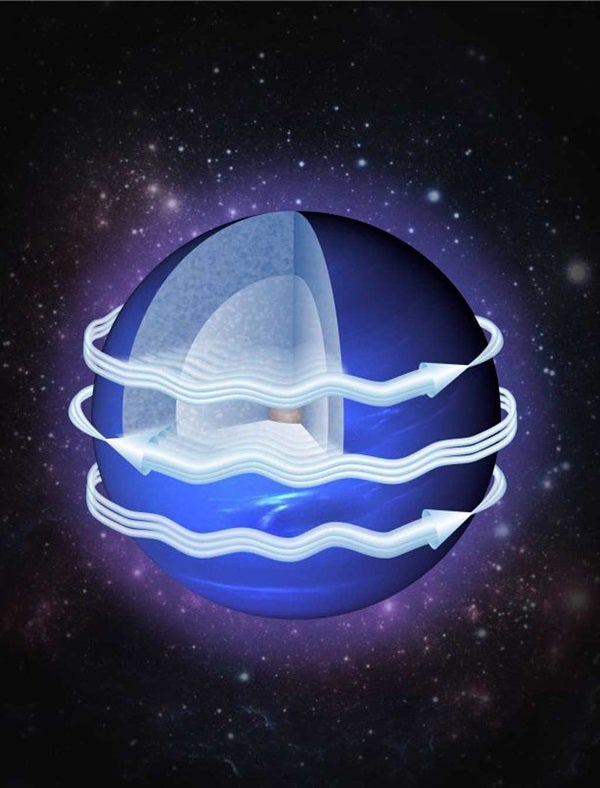But given that Uranus’ atmosphere is believed to be thick enough to swallow Earth entirely, it was not known just how far the weather perturbations reach into the planet’s interior.
Now a team of planetary scientists with the University of Arizona’s Lunar and Planetary Laboratory, including William Hubbard and Adam Showman, has published the results of new analyses that put an upper limit to the weather zone on Uranus and Neptune.
According to their data, the atmospheres on both planets go from screaming winds of infernal violence to dead quiet at a much shallower depth than previously thought.
“Our analyses show that the dynamics are confined to a thin weather layer no more than about 680 miles [1,090 kilometers] deep,” said Hubbard. “This number is an upper limit, so in reality, it is possible that the atmosphere quiets down even shallower than that.”
For the study, which was led by Yohai Kaspi from the Weizmann Institute of Science in Rehovot, Israel, the team applied computer simulations and numerical analyses to data collected by the spacecraft Voyager 2 during a flyby in 1989.
Without a means to probe the atmosphere of gas giants directly, the researchers had to rely on indirect measurements to gather clues about weather patterns on the two planets.
“For Neptune and Uranus, the only spacecraft data we have were taken with Voyager 2’s equipment more than 20 years ago, and we won’t be able to get anything that lives up to today’s standards anytime soon,” said Hubbard.
Instead, the team used deep circulation theories developed by Showman and Kaspi to predict what the gravitational fields of Neptune and Uranus should look like. This method takes advantage of the fact that large weather perturbations in the atmospheres of giant planets modify their gravitational fields in a way that allows researchers to draw conclusions about the nature and extent of those weather phenomena.
“Basically, by applying these newly developed theories, we are able to tease out new information from old data,” Hubbard said. “The reason we can constrain the weather to the upper 680 miles or so is that we would see a much stronger distortion of the gravitational field if the weather extended much deeper.”
Hubbard said he made calculations back in 1989, at the time of Voyager 2’s encounter with Neptune, “but today of course we have much better methods than two decades ago, so we can put a more accurate constraint on these phenomena than I was able to at the time.”
As a co-investigator on NASA’s Juno mission currently en route to Jupiter, Hubbard develops tools for analyzing the gravity signal from the giant gas planet with the famous Red Spot. Hubbard showed how high-precision gravity data from a close-range orbiter of Jupiter can be used to determine the depths to which Jupiter’s extraordinary zonal wind patterns penetrate.
Juno’s goal is to study the interior composition of the largest planet in our system, which is thought to have formed before the other planets and hold answers to many unsolved questions about the formation of our solar system.
“We are going to get similar data for Jupiter and Saturn, but in much higher quality than what we have from Voyager 2,” he said, “and also with higher precision than anything that has been done on Jupiter so far.”
Using two radio receivers, one on the spacecraft and one on Earth, locked in synchrony, Juno will be able to measure gravity with unprecedented accuracy, Hubbard said.
Unlike the jet streams on Uranus and Neptune, Hubbard said the winds are much more subtle on Jupiter and Saturn.
“When we start getting detailed data from Juno, we are going to use those methods to apply to what we see on Jupiter and Saturn,” he said. “We want to see how deep these weather phenomena go on those planets.”
Hubbard explained that researchers believe the atmospheric disturbances are more numerous on Jupiter and Saturn but less strong compared to Uranus and Neptune, for reasons that may have to do with the planets’ different compositions and their angles between the magnetic fields and rotational axis.
“In the case of Earth, our atmosphere is very thin and almost negligible from the point of view of gravity,” Hubbard said. “One would need extremely sensitive measurements to see the effects of the atmosphere on the Earth’s gravitational field.”
“In the case of giant gas planets, we are talking about deep, hydrogen-dominated atmospheres that are much denser, more like an ocean than an atmosphere. There is so much mass involved that it leaves a much more visible signature on the gravity.”










